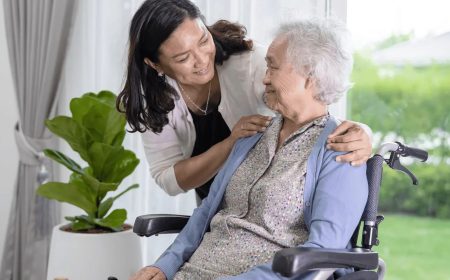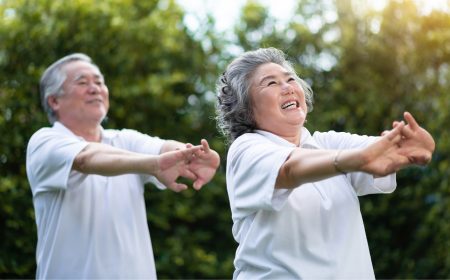
If you have just undergone knee surgery, this article is designed to provide you with general advice on how to manage recovery from home after the surgery, and guidance on home exercises to help you regain strength.
It is important to exercise after a knee replacement surgery to restore normal movement in your joints. This will help to build up strength in the joints and surrounding muscles, ease pain and swelling and help with circulation, especially right after surgery, to prevent blood clots from forming in the veins. Ultimately, exercising will help you get back to your normal activities.
Some pain in the initial period is common as you heal
You may take your pain medicine as instructed by your surgeon. Do speak to him/her if you need more medications.
Alternatively, you may use a cold pack if the wound area is painful or warm to touch. Apply the cold pack to the affected area for 15 to 20 minutes each time. You may do this 3 to 4 times per day, or after you have done your exercises.
Perform the exercises as prescribed by your therapist
If you have any questions regarding these exercises, please check with your therapist before working on the exercises.
1. Stretching Exercises
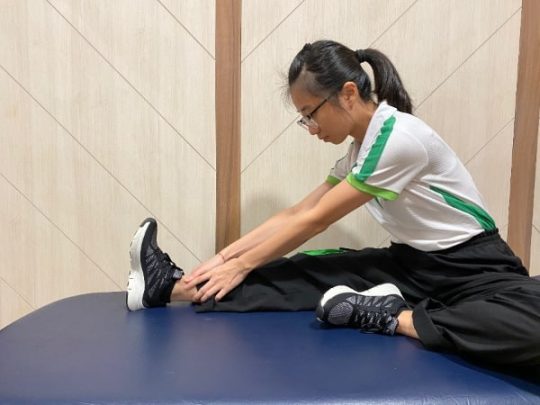
Hamstring Stretch
To stretch your lower body and hamstring muscles
- Sit on a bed/chair with your legs straightened.
- Straighten your back and extend both knees. Exhale and slowly reach forward to your toes until you feel a stretch behind the thighs.
- Hold for 20 seconds. Repeat for 5 times.
- You may repeat this on the other side.

Front Thigh Stretch
To reduce hip stiffness that may be caused by tight muscles at the front of the hip joint
- Lie on the edge of your bed.
- Gently lower your leg over the edge of the bed.
- If the bed is too high and you are unable to touch the floor with your foot, you may use a small stool/thick book to support your leg.
- Hold the stretch for 2 to 3 minutes.
- You may repeat this on the other side.


Heel Slide
To increase the range of motion at the hip and knee
- Lie/sit on your bed or on a firm surface.
- Gently slide the heel of the operated leg up towards your buttock.
- Do not overstretch.
- Hold for 10 seconds, and repeat for 10 times.
- You may repeat this on the other side.
You may use a towel to assist you, if necessary.
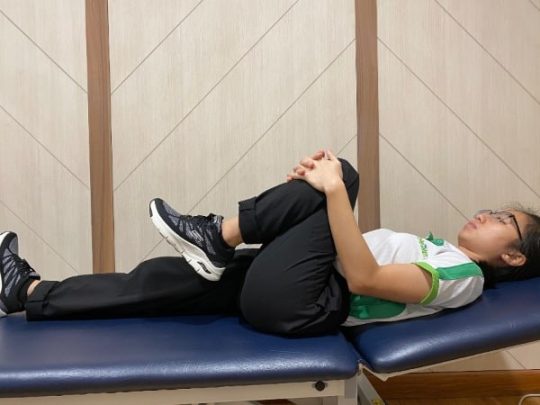
Advanced Hip/Knee Flexion
To further increase the range of motion at the hip and knee
- Lie on your bed.
- Place your hands in front or behind the operated knee.
- Bring the knee as close to your chest as possible.
- Hold for 5 to 10 seconds. Repeat for 10 times.
- You may repeat this on the other side.
2. Strengthening Exercises
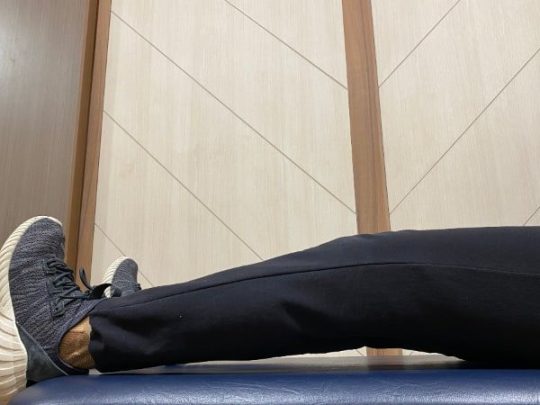
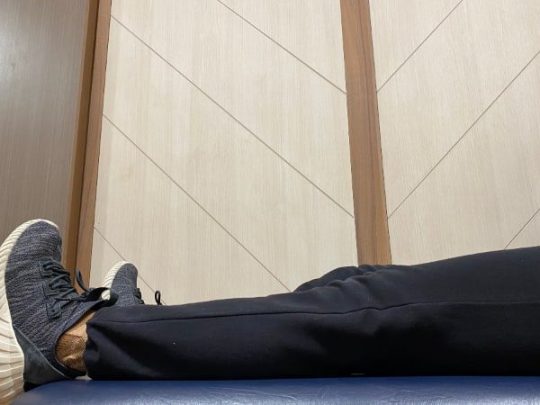
Quads Set
To strengthen the muscles at the front of the thigh by straightening the knee
- Lie on your bed.
- Tighten your thigh muscles by straightening your operated knee or pushing the knee down to the bed.
- Hold for 10 seconds. Repeat for 10 times.
- You may repeat this on the other side.
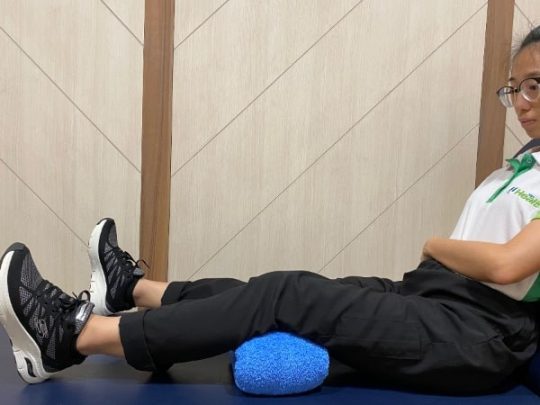
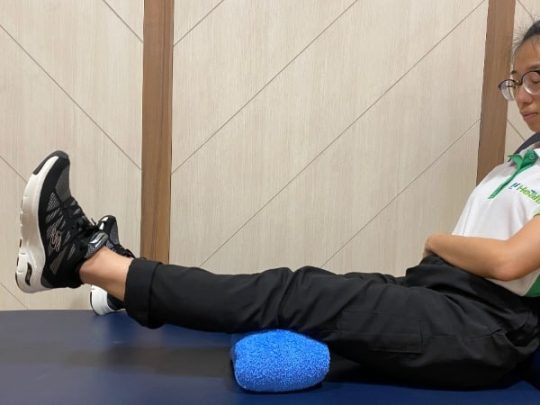
Inner Range Quads
To strengthen the muscles at the front of the thigh by straightening the knee
- Lie on your bed, or sit with your operated knee straightened.
- Place a small pillow or rolled-up towel under your operated knee.
- Tighten your knee muscles and lift your heel off the bed.
- Keep your knee firmly down on the pillow/towel.
- Hold for 10 seconds. Repeat for 10 times.
- You may repeat this on the other side.
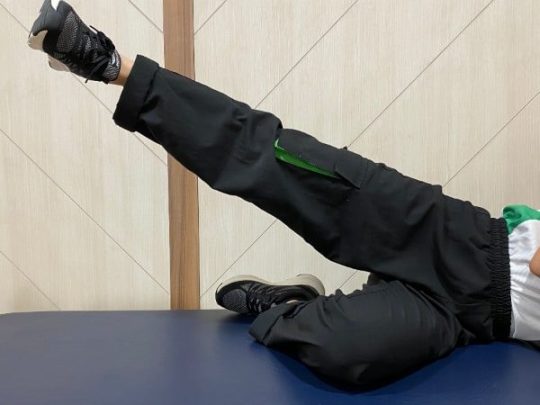
Hip Abduction (Side Lying)
To strengthen the side hip muscles
- Lie on your side. Keep your upper leg straight while bending the other leg.
- Lift the upper leg up to the ceiling, while keeping your knee straight.
- Hold for 10 seconds. Repeat for 10 times.
- Do not move your leg to the front while doing this exercise.
- You may repeat this on the other side.
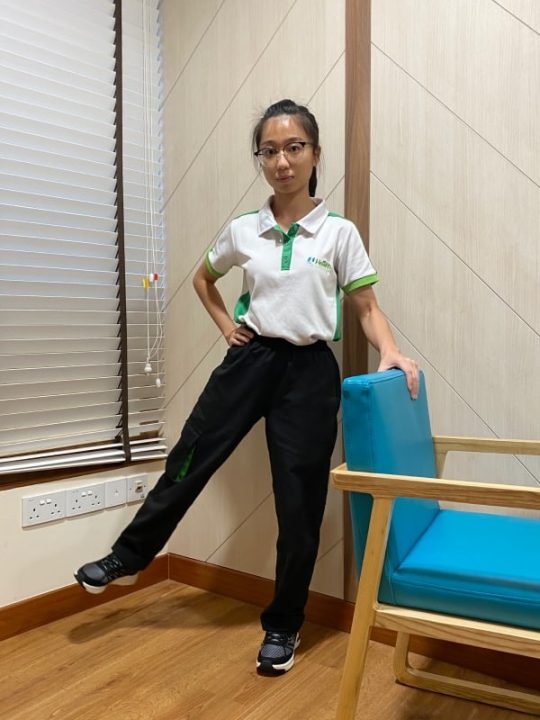
Hip Abduction (Standing)
To improve strength of side hip muscles
- Stand behind a chair with your feet slightly apart. You may hold onto a sturdy chair/table for support.
- Slowly lift your left leg to the side. Keep your back straight, your toe facing forward, and look straight.
- Hold for 10 seconds. Repeat for 10 times.
- You may repeat this on the other side.
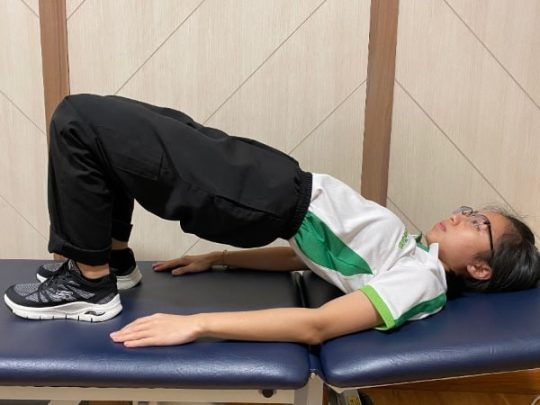
Bridging
To strengthen your buttock muscles
- Lie on your bed or on a firm surface. Bend both knees.
- Slowly raise your hips by pushing through your heels.
- Your hips should be in line with your trunk and knees.
- Hold for 10 seconds Repeat for 10 times.
- You may do 2 to 3 sets.
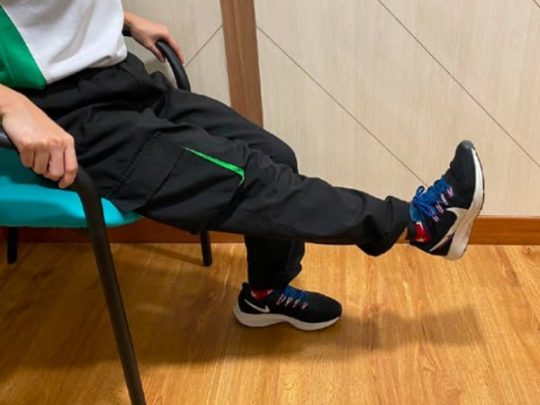
Seated Knee Extension
To strengthen your buttock muscles
- Sit straight on a sturdy chair. You may hold onto the arm rest.
- Straighten the operated knee as shown in the picture.
- Hold for 10 seconds. Repeat for 10 times.
- You may repeat this on the other side.
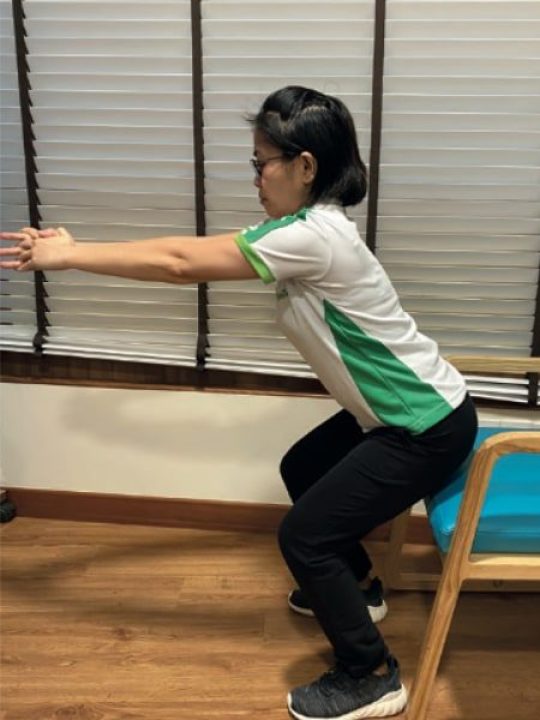
Half Squat
To strengthen your buttocks and thigh muscles
- Stand in front of a chair. Keep your legs slightly apart with your toes pointing forward.
- Slowly lower your buttocks onto the chair, just before they touch the edge of chair.
- Hold for 5 to 10 seconds.
- Slowly return to standing position.
- Repeat for 10 times.
- You may do 2 to 3 sets.
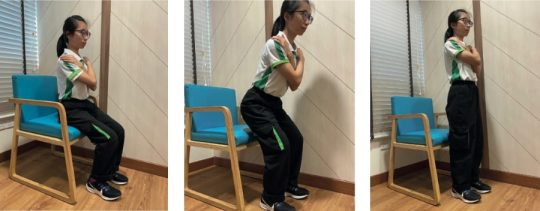
Sit-to-Stand
- Sit at the edge of a sturdy chair, with your feet flat on the floor. Keep your legs slightly apart with your toes pointing forward.
- Keep your back and neck straight. Lean forward and slightly shift your weight to the front of your feet.
- Push yourself up with your legs and come to a standing position.
- Repeat for 10 times.
- You may hold onto support if needed.
3. Balancing Exercises
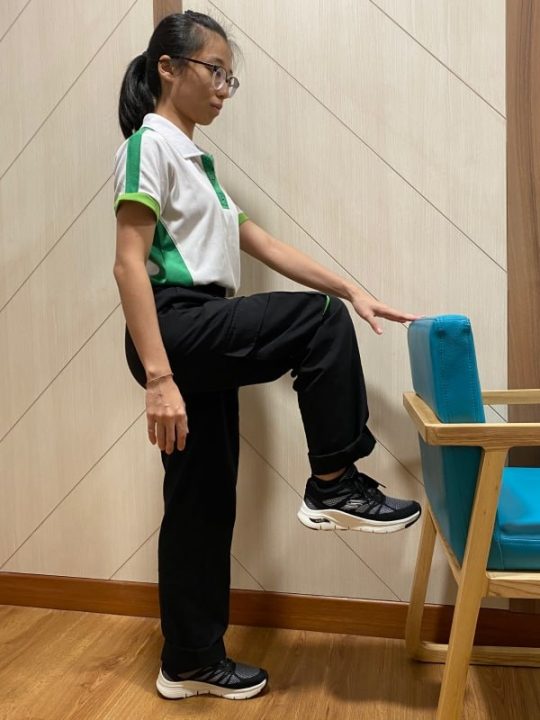
Single Leg Standing
To improve your balance, which can help in preventing falls
- Stand behind a chair with your feet slightly apart.
- Stand on one leg.
- You may hold onto the chair for support if needed.
- Hold for 10 seconds. Repeat for 10 times.
- You may repeat this on the other side.
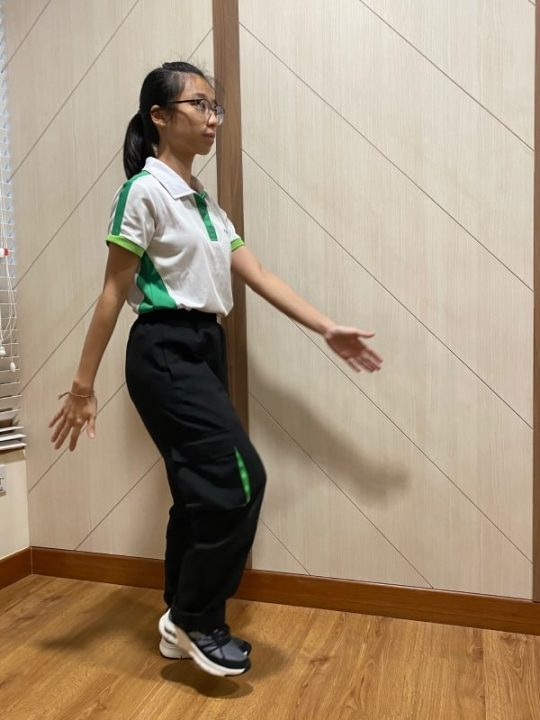
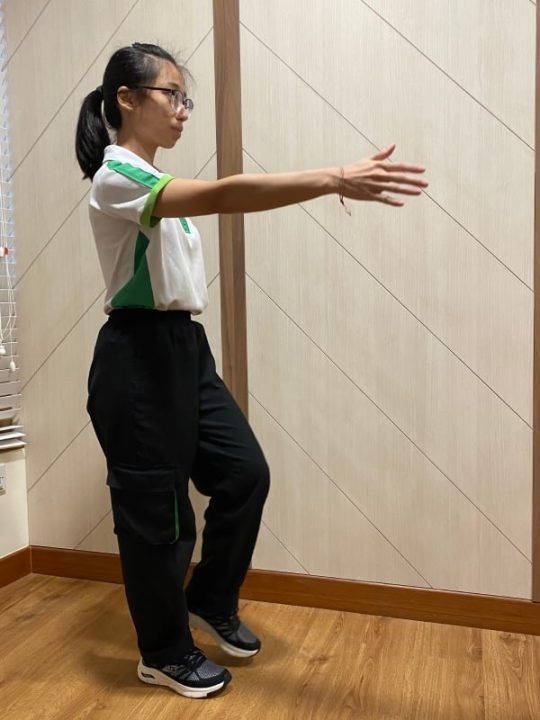
Marching in Place
To improve your balance, which can help in preventing falls
- Stand with your feet slightly apart.
- March on the spot for 2 to 3 minutes.
You may hold onto a sturdy chair/table support if needed.
4. Scar Mobilisation Exercise
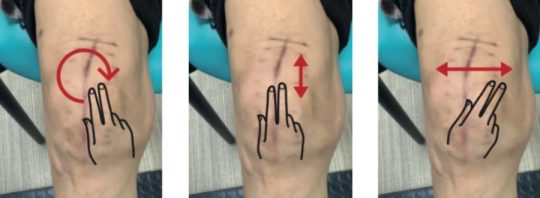
To increase range of motion in the knee and reduce pain after a knee injury
- Using your index and middle fingers, make small circles over the scar (ensure that the scar has already healed) and the skin surrounding it.
- Massage the area where the scar is, in an up-down motion.
- Massage the area where the scar is, from side to side.
Scar mobilisation exercise should only be done on scars that have healed. Stop immediately if you experience the following:
- Redness
- Bleeding
- Scar feels warmer than the skin around it
- More pain than usual where the scar is
Managing Activities of Daily Living
Please consult your therapist if you have any questions on the following activities.
Transferring from Bed to Wheelchair

Step 1: Position the wheelchair next to the non-operated leg. Lock the wheelchair and move the foot and arm rest out of the way (if necessary).

Step 2: Shift to the edge of the wheelchair so that both of your feet are resting on the floor.

Step 3: Position the operated leg slightly forward.

Step 4: Push yourself up from the wheelchair and take a step towards the chair. Hold onto the arm rest. Slowly lower yourself down onto
the chair.
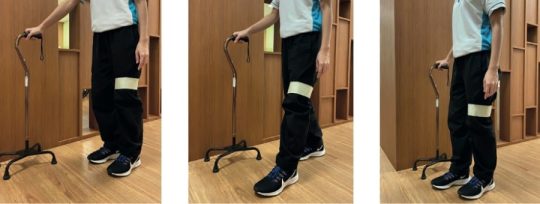
Using a Walking Stick / Quad Stick
Step 1: Hold the stick at the side of your non-operated leg. Place the stick slightly in front of your feet. If you are using a quadstick, ensure all four legs of the quadstick are in contact with the ground.
Step 2: Step forward with the operated leg such that it is aligned with the stick. Gently press down onto the stick with your hand for stability and support as you step forward.
Step 3: Step forward with the non-operated leg to align with the other foot. Repeat the process.
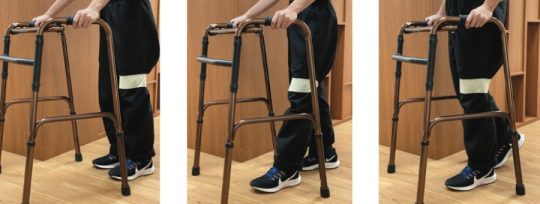
Using a Walking Frame
Step 1: Place the walking frame slightly in front of your feet. Be sure that all four legs of the frame are in contact with the ground.
Step 2: Step forward with the operated leg. Keep the foot within the frame. Avoid stepping too close to the front of the frame.
Step 3: Step forward with the non-operated leg to align with the other foot. Repeat the process.
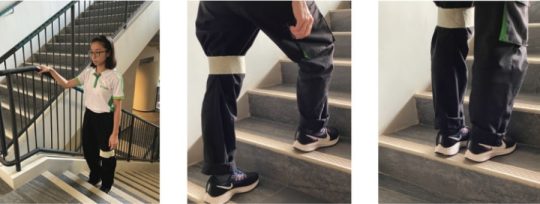
Climbing the Stairs
Up the stairs
Step 1: Place your hand on the handrail.
Step 2: Step up with the non-operated leg. If you are using a stick/quadstick, it should be placed on the same step as your operated leg. You may press lightly on the stick for support as you go up the stairs.
Step 3: Step up with the operated leg, and bring up the stick if you are using one.
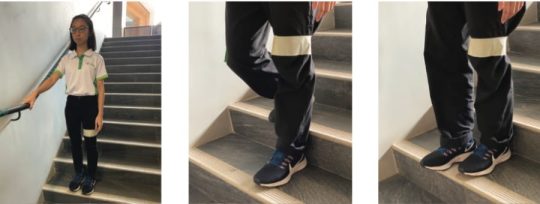
Down the stairs
Step 1: Place your hand on the handrail.
Step 2: Step down with the operated leg. If you are using a stick/quadstick, place the stick on the step below.
Step 3: Step down with the non-operated leg.
A tip to help you remember!
“Up with the good” and “Down with the bad”
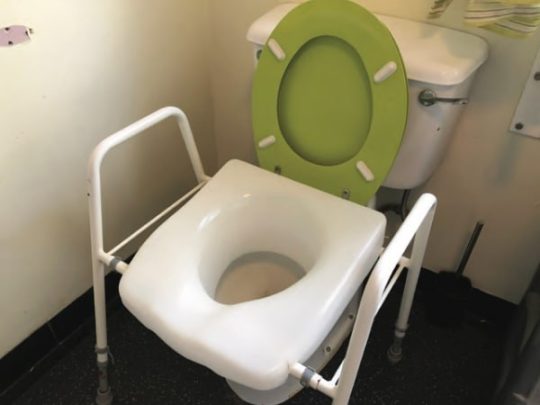
Install a raised toilet seat to help in sitting and standing
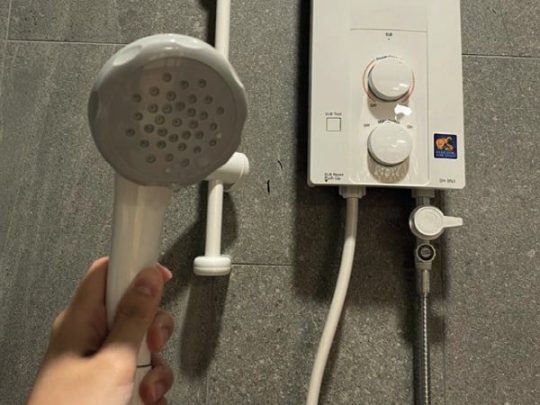
Use a hand-held shower head to help in showering, especially for those who have difficulties balancing and will need to be seated

Use a shower chair to ensure a safer environment, especially for those who are unable to stand for long periods
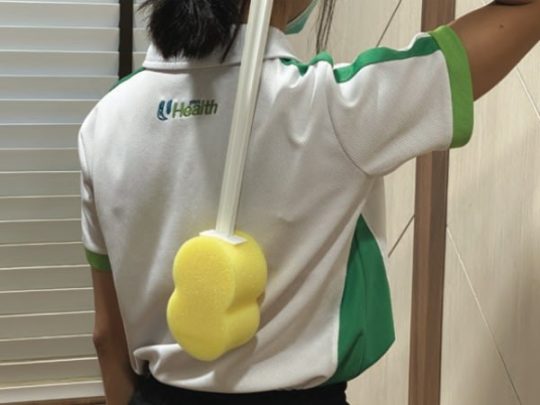
Use a long handle bath sponge to help in showering
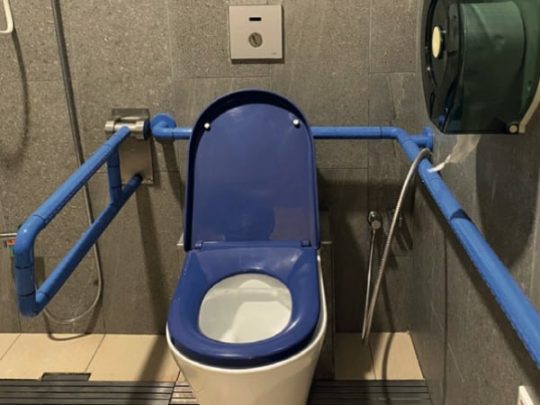
Install grab bars for support to minimise slips and falls

Use a long handle reacher to assist in wearing of pants

Use a shoe horn to help you put on slip-on shoes easily
Home care services could also be helpful for making recovery easier. Learn more here.
Get in touch with us
Need help with post-knee replacement recovery? Engage our therapists for centre-based treatment by contacting us today.

